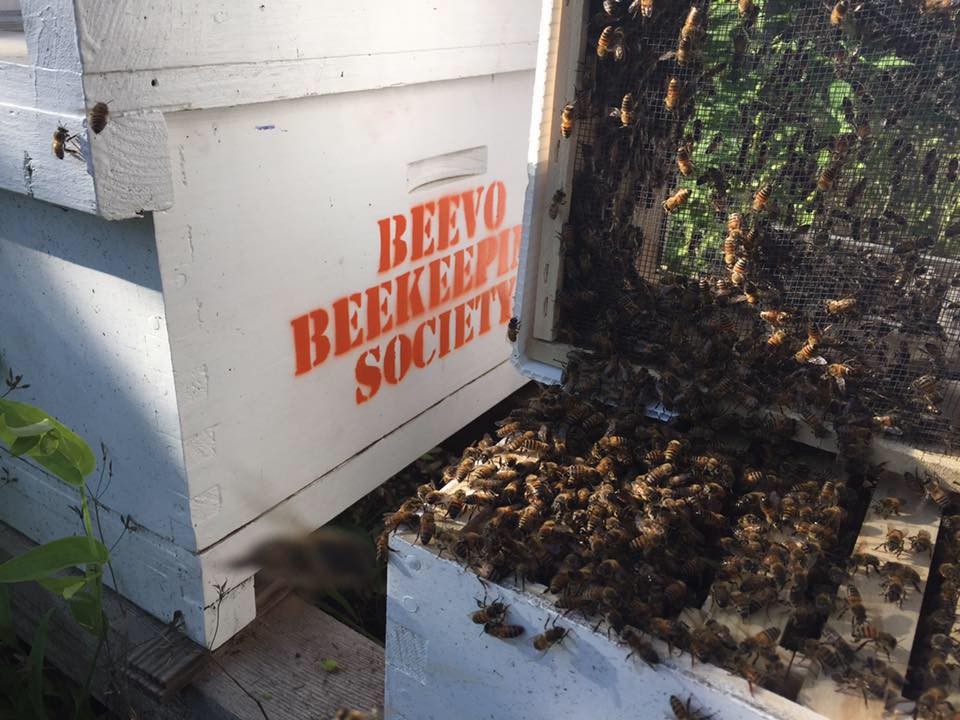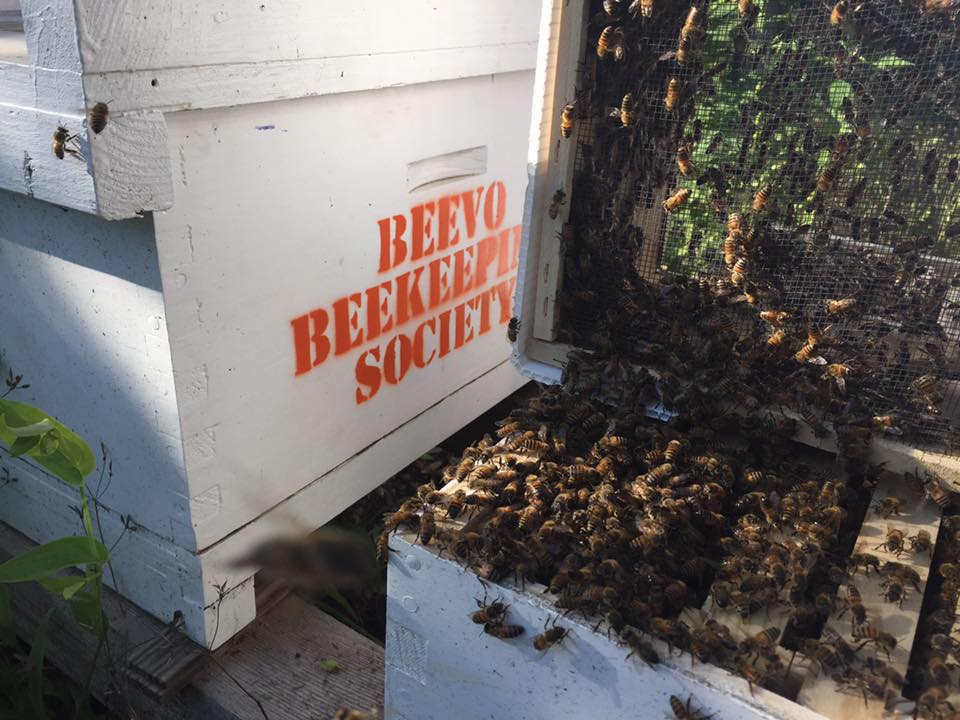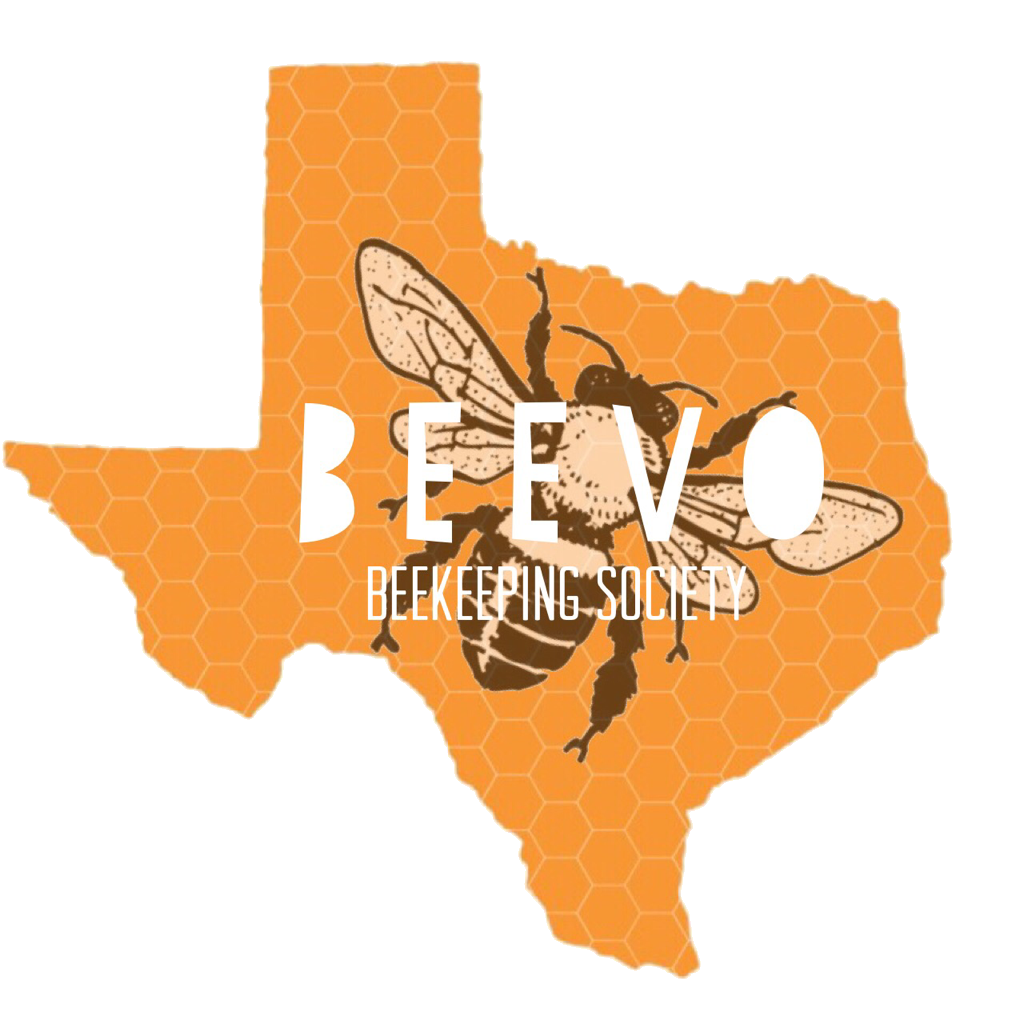Photo courtesy of BEEVO Beekeeping Society
The latest buzz among student beekeepers is that their hobby is just as therapeutic as it is sustainable.
Story by Savannah Whitmer
At BEEVO Beekeeping Society’s annual honey harvest, a completely still and almost silent semicircle of people crowded around a five gallon bucket sitting on the living room floor. Junior Hayley Woods, like the rest of us, had her eyes glued to the slow, satisfying flow of unfiltered honey that was dripping into the bucket for at least half an hour. “I love that,” she says, without looking up. “I love it so much.” The honey was a nice, dark amber color, and despite the pieces of honeycomb, wax and other floating debris floating, few could keep from dipping a finger in for a quick taste.
When a newcomer to the harvest party makes a questioning face at the prospect of sampling the honey that BEEVO members will sell on West Mall next week, society leader and senior business and public policy major Kobi Naseck laughs. “Honey is antiseptic, among other things,” he says.
At the harvest, the extraction process begins. The extractor, a silver barrel that uses centrifugal force to extract honey from the frames, sits on a coffee table in the West Campus house of junior urban studies major and BEEVO leader Cory Simmons. It looks deceptively like a keg, but there’s a hand crank on top, and honey, rather than beer, pools inside the bottom. For the harvest, the heaviest frames are removed from the hive site and “uncapped,” a process that gently scrapes away the protective layers that cover the honey. Once the honey is oozing from the frames, they’re set vertically inside the extractor, two at a time. The lid is replaced, and people take turns using the hand crank to spin the frames, flinging the honey into the barrel of the extractor. From there, it settles to the bottom and is filtered into the bucket.
Design courtesy of BEEVO
This is Naseck and Simmons’ second honey harvest. During the first day of last year’s harvest, the jars sold on campus so quickly that they closed earlier than planned to have enough to sell the next day. Though last year’s harvest brought in more frames than this year, they still expect to sell about 20 pounds of honey. The money they make will go towards new beekeeping suits for weekly hive checks, added landscaping to the garden on Speedway and 26th streets where they keep the bees, and a new tablecloth for the Thanksgiving week sale. “We put so much work into this,” Naseck says, as he stirs the puddle of honey filtering slowly into the bucket. “It’s nice to actually get something out of it.”
For Naseck and Simmons, the investment in the beekeeping practice is part of what makes the honey harvest so satisfying. There’s been a spike in public interest in beekeeping recently, which is good because bees are dying at an alarming rate. Besides saving the environment, beekeepers also get to take part in a healing hobby. “It’s hands-on, very therapeutic somehow,” Woods says. “It’s nice not to just look at them from afar, too. There’s this element of danger to it, being surrounded by all these things you know are dangerous. But they’re actually very docile and it’s really cool just to see them do what they do and get this very intimate look at them.”
As Woods is talking, a bee buzzes in through the front door, which has been propped open all afternoon by a homemade sign welcoming people into a house that smells reminiscent of sopapillas. It must be this smell that’s lured her in—and in a house full of beekeepers, it’s quickly confirmed that it is, in fact, a her. Like other people that have come in from San Gabriel Street for the past hours, she gets a taste of the harvest. Naseck dips a finger in the honey and leaves drops on the windowsill, and we gather around, with a mixture of pride and curiosity, to watch her feast.
Back at the extractor, Simmons scrapes the insides clean with a rubber spatula, wearing a red gingham apron and looking the part of an invested chef. “Alright,” he says, replacing the plastic cover and stepping back to let a newcomer try his hand at the extraction process. “Give her a whirl.”
As an urban studies major, beekeeping on campus is right up Simmons’ alley. “Urban areas usually aren’t green and aren’t hospitable for native species like bees,” he says. “We’re seeing what solutions we can find for that. It’s a hands-on, wholesome approach to being sustainable, and it’s cool to be involved in making our own honey and doing it on campus, with university resources.”
While keepers and casual observers alike are drawn to BEEVO for the environmental benefits, it’s the fascination with the species, the adrenaline rush Woods mentioned and the hands-on nature of the hobby that keeps people beekeeping. “It’s really therapeutic just to be able to work and be outside more often,” Naseck says. “Sometimes, if I have a really challenging day, I’ll just go hang out at the hive site. It’s such a nice, calm space.” As Naseck uncaps the wax cells and begins harvesting honey from the last frame, the bee—someone’s named her Matilda—gets airlifted outside on the spatula, too full to do anything other than clean her sticky wings.
People start filing out for the night, promising to come back to help bottle the honey before the sale next week. Some, like Woods, are already thinking about how the money will go towards buying and planting more pollinator-friendly plants for the hive site. “I love going to the site and making it a nice environment for the bees,” Woods says. “I know some people like the environmental aspect, but I’m just in it for the bees. The more research I do, the more I fall in love with them and realize just how useful and fascinating they are. Getting involved and figuring out how to make them thrive really gives you this connection with them.”













































